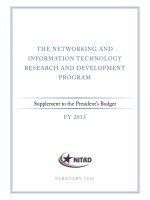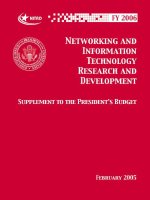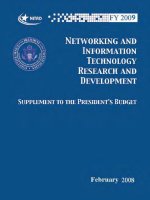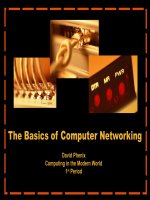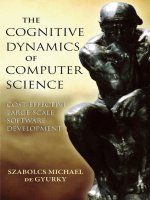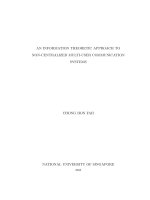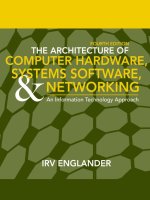The architecture of computer hardware, systems software, networking an information technology approach 4th ed i englander (wiley, 2009) bbs
Bạn đang xem bản rút gọn của tài liệu. Xem và tải ngay bản đầy đủ của tài liệu tại đây (24.2 MB, 708 trang )
FOURTH EDITION
THE ARCHITECTURE OF
COMPUTER HARDWARE,
SYSTEM SOFTWARE,
AND NETWORKING
AN INFORMATION TECHNOLOGY APPROACH
Irv Englander
Bentley University
John Wiley & Sons, Inc.
Vice President & Executive Publisher Don Fowley
Executive Editor Beth Lang Golub
Marketing Manager Christopher Ruel
Marketing Assistant Diana Smith
Design Director Harry Nolan
Senior Designer Kevin Murphy
Senior Production Editor Patricia McFadden
Senior Media Editor Lauren Sapira
Editorial Assistant Mike Berlin
Production Management Services Kate Boilard, Laserwords Maine
This book was set in 10/12 Minion by Laserwords India and printed and bound by Courier/Westford. The cover
was printed by Courier/Westford.
The book is printed on acid free paper.
Copyright 2009 John Wiley & Sons, Inc. All rights reserved. No part of this publication may be reproduced,
stored in a retrieval system or transmitted in any form or by any means, electronic, mechanical, photocopying,
recording, scanning or otherwise, except as permitted under Sections 107 or 108 of the 1976 United States
Copyright Act, without either the prior written permission of the Publisher, or authorization through payment
of the appropriate per-copy fee to the Copyright Clearance Center, Inc. 222 Rosewood Drive, Danvers, MA
01923, website www.copyright.com. Requests to the Publisher for permission should be addressed to the
Permissions Department, John Wiley & Sons, Inc., 111 River Street, Hoboken, NJ 07030-5774, (201)748-6011,
fax (201)748-6008, website />To order books or for customer service please, call 1-800-CALL WILEY (225-5945).
ISBN-13:
978-0471-71542-9
Printed in the United States of America
10 9 8 7 6 5 4 3 2 1
To four outstanding teachers and great human beings:
With your guidance, inspiration, and patience, you showed me
that everything is possible.
Dr. Sidney H. Englander (1900–1980)
and Mildred K. Englander (1906–2008),
in memoriam my father and mother
Albert L. Daugherty, in memoriam
teacher of Science in Cleveland Heights, Ohio
from 1927 to 1970
Edith B. Malin, in memoriam
teacher of English in Cleveland Heights, Ohio
from 1924 to 1958
BRIEF CONTENTS
PART ONE
AN OVERVIEW OF COMPUTER SYSTEMS
2
■ CHAPTER 1
Computers and Systems 4
■ CHAPTER 2
An Introduction to System Concepts and Systems
Architecture 38
PART TWO
DATA IN THE COMPUTER 66
■ CHAPTER 3
Number Systems 68
■ CHAPTER 4
Data Formats 96
■ CHAPTER 5
Representing Numerical Data 136
PART THREE
COMPUTER ARCHITECTURE
AND HARDWARE OPERATION 178
■ CHAPTER 6
The Little Man Computer 180
■ CHAPTER 7
The CPU and Memory 198
■ CHAPTER 8
CPU and Memory: Design, Enhancement,
and Implementation 240
■ CHAPTER 9
Input/Output 276
iv
BRIEF CONTENTS
■ CHAPTER10 Computer Peripherals 306
■ CHAPTER11 Modern Computer Systems 342
PART FOUR
NETWORKS AND DATA COMMUNICATIONS 368
■ CHAPTER12 Networks and Data Communications 370
■ CHAPTER13 Ethernet and TCP/IP Networking 422
■ CHAPTER14 Communication Channel Technology 446
PART FIVE
THE SOFTWARE COMPONENT 476
■ CHAPTER15 Operating Systems: An Overview 478
■ CHAPTER16 The User View of Operating Systems 514
■ CHAPTER17 File Management 548
■ CHAPTER18 The Internal Operating System 592
SUPPLEMENTARY CHAPTERS
On the Web at www.wiley.com/college/englander
■ SUPPLEMENTARY CHAPTER 1
An Introduction to Digital
Computer Logic
■ SUPPLEMENTARY CHAPTER 2
System Examples
■ SUPPLEMENTARY CHAPTER 3
Instruction Addressing
Modes
■ SUPPLEMENTARY CHAPTER 4
Programming Tools
v
CONTENTS
Preface
xix
About the Author
xxv
PART ONE
AN OVERVIEW OF COMPUTER SYSTEMS 2
■ CHAPTER 1
Computers and Systems 4
1.0
1.1
1.2
1.3
1.4
1.5
1.6
Introduction 5
The Starting Point 9
Components of the Computer System 12
The Hardware Component 13
The Software Component 16
The Communication Component 18
The Computer System 18
The Concept of Virtualization 20
Protocols and Standards 20
Overview of This Book 22
A Brief Architectural History of the Computer 23
Early Work 24
Computer Hardware 25
Operating Systems 28
Communication, Networks, and the Internet 33
Summary and Review 34
For Further Reading 34
Key Concepts and Terms 35
Reading Review Questions
Exercises 36
■ CHAPTER 2
An Introduction to System Concepts and Systems
Architecture 38
2.0
2.1
2.2
vi
35
Introduction 39
The General Concept of Systems 40
IT System Architectures 48
Distributed Processing Systems 49
CONTENTS
The Role of the System Architect 57
Google: A System Architecture Example
58
Summary and Review 62
For Further Reading 63
Key Concepts and Terms 63
Reading Review Questions
Exercises 64
63
PART TWO
DATA IN THE COMPUTER 66
■ CHAPTER 3
Number Systems 68
3.0
3.1
3.2
3.3
3.4
3.5
3.6
3.7
3.8
Introduction 69
Numbers as a Physical Representation 70
Counting in Different Bases 70
Performing Arithmetic in Different Number Bases 74
Numeric Conversion between Number Bases 77
An Alternative Conversion Method 79
Hexadecimal Numbers and Arithmetic 81
A Special Conversion Case—Number Bases that are
Related 81
Fractions 83
Fractional Conversion Methods 86
Mixed Number Conversions 89
Summary and Review 89
For Further Reading 90
Key Concepts and Terms 90
Reading Review Questions
Exercises 91
■ CHAPTER 4
Data Formats 96
4.0
4.1
4.2
4.3
4.4
4.5
Introduction 97
General Considerations 97
Alphanumeric Character Data 100
Keyboard Input 106
Alternative Sources of Alphanumeric Input
Image Data 109
Bitmap Images 110
Object Images 114
Representing Characters as Images 117
Video Images 117
Image and Video Input 118
Audio Data 119
Data Compression 123
107
90
vii
viii
CONTENTS
4.6
4.7
Page Description Languages 124
Internal Computer Data Format 125
Numerical Character to Integer Conversion
127
Summary and Review 128
For Further Reading 129
Key Concepts and Terms 130
Reading Review Questions
Exercises 131
■ CHAPTER 5
Representing Numerical Data 136
5.0
5.1
5.2
5.3
5.4
Introduction 137
Unsigned Binary and Binary-Coded Decimal
Representations 138
Representations for Signed Integers 141
Sign-and-magnitude Representation 142
Nine’s Decimal and 1’s Binary Complementary
Representations 143
Ten’s Complement and 2’s Complement 150
Overflow and Carry Conditions 153
Other Bases 153
Summary of Rules for Complementary Numbers 154
Real Numbers 155
A Review of Exponential Notation 155
Floating Point Format 157
Normalization and Formatting of Floating Point Numbers
A Programming Example 162
Floating Point Calculations 163
Floating Point in the Computer 165
Conversion between Base 10 and Base 2 167
Programming Considerations 168
Summary and Review 169
For Further Reading 170
Key Concepts and Terms 171
Reading Review Questions
Exercises 172
PART THREE
COMPUTER ARCHITECTURE AND HARDWARE
OPERATION 178
■ CHAPTER 6
130
The Little Man Computer 180
6.0
6.1
Introduction 181
Layout of the Little Man Computer
181
171
159
CONTENTS
6.2
6.3
6.4
6.5
6.6
Operation of the LMC 183
A Simple Program 185
An Extended Instruction Set 186
The Instruction Cycle 189
A Note Regarding Computer Architectures
Summary and Review 192
Reading Review Questions
■ CHAPTER 7
192
Key Concepts and Terms
193
Exercises
193
194
The CPU and Memory 198
7.0
7.1
7.2
7.3
7.4
7.5
7.6
7.7
7.8
Introduction 199
The Components of the CPU 200
The Concept of Registers 201
The Memory Unit 204
The Operation of Memory 204
Memory Capacity 208
Primary Memory Characteristics and Implementation 209
The Fetch-Execute Instruction Cycle 211
Buses 214
Bus Characteristics 214
Classification of Instructions 218
Data Movement Instructions (LOAD, STORE, and Other
Moves) 219
Arithmetic Instructions 221
Boolean Logic Instructions 222
Single Operand Manipulation Instructions 222
Bit Manipulation Instructions 222
Shift and Rotate Instructions 223
Program Control Instructions 224
Stack Instructions 225
Multiple Data Instructions 228
Other Instructions 229
Instruction Word Formats 229
Instruction Word Requirements and Constraints 230
Summary and Review 234
Key Concepts and Terms
Exercises
237
235
For Further Reading
234
Reading Review Questions
235
ix
x
CONTENTS
■ CHAPTER 8
CPU and Memory: Design, Enhancement,
and Implementation 240
8.0
8.1
8.2
8.3
8.4
8.5
8.6
Introduction 241
CPU Architectures 242
Overview 242
Traditional Modern Architectures 243
VLIW and EPIC Architectures 244
CPU Features and Enhancements 246
Introduction 246
Fetch-Execute Cycle Timing Issues 247
A Model for Improved CPU Performance 249
Scalar and Superscalar Processor Organization 253
Memory Enhancements 256
Wide Path Memory Access 257
Memory Interleaving 258
Cache Memory 259
The Compleat Modern Superscalar CPU 263
Multiprocessing 265
A Few Comments on Implementation 269
Summary and Review 269
For Further Reading 270
Key Concepts and Terms 271
Reading Review Questions
Exercises 272
■ CHAPTER 9
271
Input/Output 276
9.0
9.1
9.2
9.3
9.4
9.5
Introduction 277
Characteristics of Typical I/O Devices
Programmed I/O 284
Interrupts 285
Servicing Interrupts 286
The Uses of Interrupts 288
Multiple Interrupts and Prioritization
Direct Memory Access 297
I/O Modules 300
278
293
Summary and Review 302
For Further Reading 303
Key Concepts and Terms 303
Reading Review Questions
Exercises 304
304
CONTENTS
■ CHAPTER10 Computer Peripherals 306
10.0
10.1
10.2
10.3
10.4
10.5
10.6
10.7
10.8
10.9
Introduction 307
The Hierarchy of Storage 308
Solid State Memory 310
Magnetic Disks 311
Disk Arrays 317
Optical Disk Storage 318
Magnetic Tape 321
Displays 322
Liquid Crystal Display Technology 328
CRT Display Technology 329
OLED Display Technology 330
Printers 330
Laser Printers 331
Inkjet Printers 332
Thermal Wax Transfer and Dye Sublimation Printers
User Input Devices 333
Keyboards and Pointing Devices 333
Scanners 335
Multimedia Devices 335
Network Communication Devices 335
Summary and Review 336
For Further Reading 337
Key Concepts and Terms 337
Reading Review Questions
Exercises 339
■ CHAPTER11 Modern Computer Systems 342
11.0 Introduction 343
11.1 Putting All the Pieces Together 345
11.2 Input/Output System Architectures 353
I/O Bus Architecture 354
Channel Architecture 357
Blurring the Line 358
11.3 Computer Interconnection: A Brief Overview
11.4 Clusters 360
Overview 360
Classification and Configuration 360
Beowulf Clusters 362
359
333
338
xi
xii
CONTENTS
11.5 High-Performance Computing
Grid Computing 364
363
Summary and Review 364
For Further Reading 365
Key Concepts and Terms 365
Reading Review Questions
Exercises 366
366
PART FOUR
NETWORKS AND DATA COMMUNICATIONS 368
■ CHAPTER12 Networks and Data Communications 370
12.0 Introduction 371
12.1 The Impact of Networking on Business Processes and User
Access to Knowledge and Services 372
12.2 A Simple View of Data Communications 373
12.3 Basic Data Communication Concepts 376
Messages 377
Packets 377
General Channel Characteristics 378
Packet Routing 382
12.4 TCP/IP, OSI, and Other Communication Models 386
Overview 386
The TCP/IP Network Model 387
The OSI Network Model 395
Addressing 396
12.5 Types of Networks 398
Network Topology 399
Local Area Networks 402
Backbone Networks 407
Metropolitan Area Networks 409
Wide Area Networks (WAN) 411
Internet Backbones and the Internet 412
Piconets 414
12.6 Standards 415
Summary and Review 416
For Further Reading 417
Key Concepts and Terms 417
Reading Review Questions
Exercises 419
418
CONTENTS
■ CHAPTER13 Ethernet and TCP/IP Networking 422
13.0 Introduction 423
13.1 Introducing The Process—The Application Layer 423
13.2 Domain Names and DNS Services 424
Domain Name System Directory Services 424
13.3 Next Steps—TCP and the Transport Layer 429
13.4 The Network Layer, IP Addresses, and ARP 430
IP Addresses 431
Dynamic Host Configuration Protocol (DHCP) 433
The Operation of IP 434
13.5 The Data Link Layer 435
Hub-Based Ethernet 436
Switched Ethernet 437
13.6 Quality of Service 437
13.7 Network Security 438
Physical and Logical Access Restriction 439
Encryption 440
13.8 Alternative Protocols 440
MPLS 440
ATM 441
SONET/SDH 441
Frame Relay 441
Summary and Review 442
For Further Reading 442
Key Concepts and Terms 443
Reading Review Questions
Exercises 443
■ CHAPTER14 Communication Channel Technology 446
14.0 Introduction 447
14.1 Communication Channel Technology 447
14.2 The Fundamentals of Signaling Technology 450
Analog Signaling 451
Digital Signaling 460
Modems and Codecs 465
14.3 Transmission Media and Signaling Methods 466
14.4 Wireless Networking 468
Wi-Fi 469
443
xiii
xiv
CONTENTS
Summary and Review 471
For Further Reading 471
Key Concepts and Terms 471
Reading Review Questions
Exercises 473
472
PART FIVE
THE SOFTWARE COMPONENT 476
■ CHAPTER15 Operating Systems: An Overview 478
15.0
15.1
15.2
15.3
Introduction 479
The Barebones Computer System 480
The Operating Systems Concept: An Introduction 481
Services and Facilities 488
User Interface and Command Execution Services 489
File Management 490
Input/Output Services 491
Process Control Management 492
Memory Management 493
Scheduling and Dispatch 493
Secondary Storage Management 496
Network and Communications Support Services 496
Security and Protection Services 497
System Administration Support 498
15.4 Organization 502
15.5 Types of Computer Systems 505
Summary and Review 509
For Further Reading 510
Key Concepts and Terms 510
Reading Review Questions
Exercises 511
510
■ CHAPTER16 The User View of Operating Systems 514
16.0 Introduction 515
16.1 Purpose of the User Interface 516
16.2 User Functions and Program Services 518
Program Execution 518
File Commands 519
Disk and Other I/O Device Commands 520
Security and Data Integrity Protection 521
Interuser Communication and Data Sharing Operations
System Status Information 522
Program Services 523
521
CONTENTS
16.3 Types of User Interface 524
The Command Line Interface 525
Batch System Commands 527
Graphical User Interfaces 528
Trade-offs in the User Interface 533
Software Considerations 535
16.4 X Window and Other Graphics Display Methodologies 536
16.5 Command and Scripting Languages 539
The Elements of a Command Language 541
The Command Language Start-up Sequence Files 542
16.6 Services to Programs 542
Summary and Review 544
For Further Reading 544
Key Concepts and Terms 544
Reading Review Questions
Exercises 545
■ CHAPTER17 File Management 548
17.0
17.1
17.2
17.3
17.4
17.5
17.6
17.7
17.8
17.9
17.10
Introduction 549
The Logical and Physical View of Files 549
The Role of the File Management System 554
Logical File Access Methods 560
Sequential File Access 560
Random Access 560
Indexed Access 561
Physical File Storage 562
Contiguous Storage Allocation 562
Noncontiguous Storage Allocation 564
Indexed Allocation 566
Free Space Management 568
Tape Allocation 569
CD, DVD, and Flash Drive Allocation 570
File Systems, Volumes, Disks, Partitions, and Storage
Pools 570
The Directory Structure 573
Tree-Structured Directories 575
Acyclic-Graph Directories 577
Network File Access 581
Storage Area Networks 582
File Protection 584
Journaling File Systems 585
545
xv
xvi
CONTENTS
Summary and Review 586
For Further Reading 586
Key Concepts and Terms 587
Reading Review Questions
Exercises 588
587
■ CHAPTER18 The Internal Operating System 592
18.0 Introduction 593
18.1 Fundamental OS Requirements 594
Example: A Simple Multitasking Operating System 596
18.2 Starting the Computer System: The Bootstrap 599
18.3 Processes and Threads 601
Process Creation 604
Process States 605
Threads 606
18.4 Basic Loading and Execution Operations 607
18.5 CPU Scheduling and Dispatching 608
High-Level Scheduler 608
Dispatching 610
Nonpreemptive Dispatch Algorithms 612
Preemptive Dispatch Algorithms 613
18.6 Memory Management 615
Memory Partitioning 615
18.7 Virtual Storage 617
Overview 617
Pages and Frames 618
The Concept of Virtual Storage 623
Page Faults 624
Working Sets and the Concept of Locality 626
Page Sharing 627
Page Replacement Algorithms 627
Thrashing 629
Page Table Implementation 630
Segmentation 632
Process Separation 633
18.8 Secondary Storage Scheduling 633
First-Come, First-Served Scheduling 633
Shortest Distance First Scheduling 634
Scan Scheduling 634
N-STEP C-SCAN Scheduling 635
CONTENTS
18.9 Network Operating System Services 635
OS Protocol Support and Other Services 635
18.10 Other Operating System Issues 638
Deadlock 638
Other Issues 640
18.11 Virtual Machines 641
Summary and Review 643
For Further Reading 644
Key Concepts and Terms 644
Reading Review Questions
Exercises 647
Bibliography
Index
653
665
SUPPLEMENTARY CHAPTERS
On the Web at www.wiley.com/college/englander
■ SUPPLEMENTARY CHAPTER 1
S1.0
S1.1
S1.2
S1.3
An Introduction to Digital
Computer Logic
Introduction
Boolean Algebra
Gates and Combinatorial Logic
Sequential Logic Circuits
Summary and Review
For Further Reading
Key Concepts and Terms
Reading Review Questions
Exercises
■ SUPPLEMENTARY CHAPTER 2
System Examples
S2.0 Introduction
S2.1 Hardware Examples
The x86 Family
The POWER Family
The IBM System 360/370/390/zSeries Family
S2.2 Operating System Examples
The Microsoft Windows Family
UNIX and Linux
The IBM z/OS Operating System
S2.3 Networking Examples
645
xvii
xviii
CONTENTS
Summary and Review
For Further Reading
Key Concepts and Terms
Reading Review Questions
Exercises
■ SUPPLEMENTARY CHAPTER 3
S3.0
S3.1
S3.2
S3.3
Instruction Addressing
Modes
Introduction
Register Addressing
Alternatives to Absolute Addressing
Alternatives to Direct Addressing
Immediate Addressing
Indirect Addressing
Register Indirect Addressing
Indexed Addressing
Indirect Indexed and Indirect Indexed Addressing
Summary and Review
For Further Reading
Key Concepts and Terms
Reading Review Questions
Exercises
■ SUPPLEMENTARY CHAPTER 4
Programming Tools
S4.0
S4.1
S4.2
S4.3
Introduction
Program Editing and Entry
The Concept of Program Translation
Assembly Language and the Assembler
Operation of the Assembler
Assembly Language Formats
Features and Extensions
Relocatability
S4.4 Program Language Description and Rules
A Description of Written English
Programming Language Rules
Computer Language Descriptions
The Compilation Process
Interpreters
S4.5 Linking and Loading
S4.6 Debuggers
Summary and Review
For Further Reading
Key Concepts and Terms
Reading Review Questions
Exercises
PREFACE
The modern world offers lots of readily available online resources for learning. Wikipedia,
Google, news sources, millions of Web sites and blogs, even YouTube, offer access to
information in nearly any subject that triggers your curiosity and interest. Nonetheless, I
continue to believe that for deep understanding of something, nothing beats the integrated
approach and focus of an old-fashioned printed-on-paper textbook.
When I open a new book, in any subject, the first thing I want to know is what the
book has to offer that makes it worth my while to read it. I would like to try to help you
answer that question for the book that you’re holding in your hand.
The information systems and technology fields are wonderfully exciting places to be! It
seems as though every day brings new developments that alter the ways we create and work
with information. Of course, with this excitement comes a challenge. To be a successful
player in IS or IT we have to be adaptable and flexible.
Much of the change occurs around computer system technology. The computer is,
after all, at the foundation of information systems. A deep understanding of computer
systems is, therefore, an essential element of success. We must be able to understand each
new development, assess its value, and place it in the context of our knowledge of computer
systems.
The subject of this book is the architecture of computer systems. Computer architecture
is about the structure and operation of digital computers. Computer architecture is
concerned with the operational methods of the hardware; with the services provided by
operating system software; with the acquisition, processing, storage, and output of data;
and with the interaction between computers.
There is a tendency for people in information systems and technology to neglect a study
of computer architecture. After all, the technology changes so rapidly—is it really worth
trying to understand something that may be out of date by the time I finish this book? There
is no question that computer technology has evolved rapidly. The computer in a personal
computer, or even in a cell phone or MP3 player is far more powerful than the mainframe
computer of twenty-five years ago, with memory, disk and flash storage capacity, display
and multimedia capability, and ease of use that would have been unthinkable just a few
years ago. Even more important, connecting systems to work together is now routine and
simple.
Interestingly enough, however, as profound as advances in the technology have been,
the concepts of computer architecture that really matter have changed only nominally
over the last sixty years. The new technologies are based on a foundation of architectural
concepts that were developed many years ago. The architecture of a modern computer
system was developed in the 1940s. The instruction set in a modern personal computer
xix
xx
PREFACE
is nearly identical to that of computers built in the 1950s and 1960s. Modern operating
system techniques were developed in the 1960s. The graphical user interface is based
on a 1960s project. The Internet is built from concepts developed more than forty
years ago.
So you see that an understanding of computer architecture makes it possible to ‘‘ride
the wave’’ of technological change, secure in the feeling that you are equipped to deal with
new developments as they occur, and to have fun doing so. When you are done reading
this book you will have substantial knowledge about how a computer works and a good
understanding of the operating concepts, the hardware, and system software that make up
a computer. You will see the interaction between computers and between data and the
computer. Plus, you will have learned lots of jargon that you can show off at parties and
job interviews.
This textbook is designed for a wide range of readers, both undergraduate and
graduate. The material is specifically directed toward IS and IT majors. There are no explicit
prerequisites, although the book assumes that the student is familiar with a personal
computer. It also assumes (but does not require) some basic programming skills: although
there is no programming in the book, program code is occasionally used as an example to
clarify an idea, and a knowledge of programming is helpful at understanding instruction
set design and program execution concepts. The material in this textbook conforms to
the criteria of the IT Infrastructure course as described in the December 2008 draft of
the joint IS 2008 standard curriculum. Although the material in this book may be useful
as background for system design and implementation project courses, the course can be
placed anywhere in the curriculum.
Most instructors will not cover the entire textbook in a single semester. The organization
of the book is designed to allow an instructor to cover the major topic areas in different
levels of depth, depending on the experience and needs of the students. On the other hand,
it is my intention that this book will serve a student as a useful reference long after the
formal course is completed. It is designed for use as a book where a professional can look
up the basic concepts that clarify new developments as they occur.
This text is the outgrowth of courses that I have taught to IS majors and minors at
Bentley University at both the undergraduate and graduate level for thirty years. Student
responses to the material and the approach have generally been very enthusiastic. Many
students have returned after graduation to tell me that their knowledge in this area has
directly contributed to their career development. Along the way, student comments have
also been extremely helpful to me in the book’s continuing evolution.
Those familiar with previous editions will notice that the organization of the fourth
edition has undergone substantial revision to reflect current technological practices and
trends. In particular, it is no longer reasonable to discuss computers as individual units
without also considering the networks that tie them together; computer networking is
now covered thoroughly in its own section, and there is an increased emphasis on the
integration and synergy of the various components of the computer system and on the
system as a whole. Still, the basic philosophy, organization, and approach remain essentially
similar to those of the first edition, reflecting the unchanging nature of the underlying
principles.
PREFACE
xxi
ORGANIZATION OF THE FOURTH EDITION
OF THE BOOK
The biggest challenge for me as the author of this book has been to preserve the guiding
principles established in the first edition, while reflecting the major changes in the way
computers are used, in the rapid deployment of new technology, and in the resulting
evolution of IS/IT curriculum to reflect those changes. The fourth edition is the most
substantial revision of this book to date, with a new title, a new chapter on systems,
and significantly increased coverage of networking. The case study chapters have been
updated and moved to the Web, along with the chapter on programming tools and the
supplementary chapters on logic design and instruction addressing. Still, users of previous
editions will find much that is familiar; after all, the way in which computers are used
in IS/IT may have changed, but the basic guiding principles of computer architecture are
essentially the same as they have been for many years.
The book is now organized into five parts totaling eighteen chapters, plus four
additional supplementary chapters that are posted on the Web. The first part serves as an
introduction and overview of the role of the computer in information systems; it introduces
the concept of a system and provides a brief introduction to each of the components that
make up a modern computer system. Each of the remaining four parts deals with a single
architectural aspect of the computer system.
Part Two discusses the role and representation of data in the computer. Here we
consider numbers, text, sound, images, video, and other data forms. Part Three presents
the hardware architecture and operational concepts. It introduces the components of a
computer and shows how they collaborate to execute computer instructions, discusses
the nature of a computer instruction set, and explores the interaction between the CPU,
memory, and I/O peripheral devices. Part Four presents a thorough introduction to the
basics of computer networking. Part Five discusses the system software, the programs
that function to make the resources of the computer system, and other interconnected
computer systems and components, accessible to the user and to application programs.
The approach within each group of chapters is layered. Each new layer builds upon the
previous material to add depth and understanding to the reader’s knowledge. Each topic
section consists of a short introduction that places the topic to be discussed into the context
of the computer system as a whole and then lays out in detail the organization of the
chapters within the section. Each topic area is introduced as gently as possible, using ideas
and examples that are already familiar to the student. Successive material is progressive and
accumulative. In addition to the numerous examples that are used throughout the text,
the supplementary chapters offer substantial case studies that show application of the text
material to current examples of importance. Overall, the approach is gentle, progressive,
and accumulative. As much as possible, each section is self-contained.
An overview of the organization of each part follows. More details can be found in the
introductions to each section.
Part One consists of two chapters that present a short overview of computing, placing
architectural concepts into the context of information technology. Chapter 1 introduces
the components of a computer system and shows the relationships among the components.
xxii
PREFACE
It also presents a simple model of computing and discusses the importance of standards
and protocols in the development of computer systems. The chapter concludes with a
short history of computers from the architectural point of view. Chapter 2 focuses on the
concepts of systems, models, and system architectures, using various types of computer
systems as examples.
Chapters 3 through 5 comprise Part Two. Chapter 3 introduces number systems and
basic number system operations; it then explores the relationships between numbers in
different number bases and the conversion techniques between the different representations. Chapter 4 investigates different types of data formats, including alphanumeric,
image, video, and audio formats. It considers the relationship between numerical and
character-based representations and briefly introduces various devices and data formats
used for data input and output. Chapter 5 studies the various formats that are used to
represent and to perform calculations on integer and floating point numbers.
Part Three discusses the hardware architecture and operational aspects of the computer.
Chapter 6 begins the study with the introduction of the Little Man Computer, a simple
model that provides a surprisingly accurate representation of the CPU and memory. The
model is used to develop the concept of an instruction set and to explain the basic principles
of the von Neumann architecture. Chapter 7 extends the discussion to a real computer.
It introduces the components of the CPU and shows their relationship to the Little Man
Computer model. It introduces the bus concept, explains the operation of memory, presents
the instruction fetch-execute cycle, and discusses the instruction set. It identifies important
classes of instructions and discusses the ways in which instructions can be categorized.
Chapter 8 expands the material in Chapter 7 to consider more advanced features of the
CPU and memory. It offers an overview of various CPU architectures. It continues with a
discussion of techniques for improving memory access, particularly cache memory, and an
introduction to current CPU organization, design, and implementation techniques, including pipelining and superscalar processing. This chapter also introduces multiprocessing (or
multicore, in current terminology) concepts.
Chapter 9 presents the principles of I/O operation, and Chapter 10 illustrates how I/O
is performed in various I/O devices. Chapter 11 discusses the computer system as a whole. It
discusses interconnection techniques and integration of the various hardware components.
It also addresses the interconnection of computers to increase computer performance and
reliability, with a specific focus on clustering and on grid computing.
Three supplementary chapters on the Web provide additional resources to support the
chapters in Part Three. Supplementary Chapter 1 (SC1) offers an introduction to Boolean
algebra, combinatorial logic, and sequential logic for those readers that would like a deeper
understanding of the computer in its simplest and most elegant form. Supplementary
Chapter 2 (SC2) offers three detailed case studies of important architectures: the Intel
x86 family, including the Pentium IV architecture and Itanium extensions, the PowerPC,
and the IBM zSystem. Supplementary Chapter 3 (SC3) discusses alternative approaches to
instruction addressing.
Part Four presents a thorough introduction to networking. Chapter 12 introduces
the major features and characteristics of networking, including a careful introduction to
communication channels, a detailed discussion of layered network models, with particular
emphasis on TCP/IP and Ethernet models, an introduction to network topologies, and
finally, a discussion of the different types of networks in use, including LANs, MANs, WANs,
PREFACE
xxiii
and the backbones that form the foundation of the Internet. Chapter 13 expands on the
material in Chapter 12 to discuss specific details of various layers, including discussions of
DNS, TCP connections, IP and physical address resolution, the operation of Ethernet, alternative protocols, and more. Chapter 14 focuses primarily on communication channel technology, including analog and digital signaling, modulation and data conversion techniques
between analog and digital, the characteristics of transmission media, and wireless networking. A portion of Chapter 14 appeared in previous editions as a supplementary chapter.
Part Five is dedicated to a discussion of system software. Chapter 15 provides an
overview of the operating system. It explains the different roles played by the operating
system and introduces the facilities and services provided. Chapter 16 presents the role of
the operating system from the viewpoint of the user of a system. Chapter 17 discusses the
all-important topic of file systems. Chapter 18 discusses the operating system as a resource
manager, with an in-depth discussion of memory management, scheduling, process control,
network services, and other basic operating system services. Chapter 18 includes a detailed
introduction to virtual memory technique, and also includes an introduction to virtual
machines. In addition to its hardware discussions, Supplementary Chapter 3 also provides
current Windows, UNIX/Linux, and z/OS case studies.
A fourth supplementary chapter provides an introduction to the system development
software that is used for the preparation and execution of programs.
A detailed list of the changes between the second and third editions of the book can be
found at the book Web site, www.wiley.com/college/englander.
This book has been a continuing labor of love. My primary goal has been to create
and maintain a textbook that explains computer architecture in a way that conveys to you,
the reader, the sense of excitement and fun that I believe makes a career in information
systems and technology so satisfying. I hope that I have succeeded to some extent.
ADDITIONAL RESOURCES
Additional resources for students and instructors may be found at the textbook Web
site, www.wiley.com/college/englander. I can also be reached directly by e-mail at
Although I am happy to communicate with students, I am
unable to supply tutorial help or answers to review questions and exercises in the book.
ACKNOWLEDGMENTS
I’ve discovered that a major, ongoing textbook project is a formidable task. Many individuals
have helped to make the task manageable—and kept me going when, from time to time,
I became convinced that textbooks really do appear by magic and are not written by
humans. It is impossible to thank people adequately for all their help and support. First
and foremost, a special thank you to my nearest and dearest friends, Wilson Wong, Rich
Braun, Luis Fernandez, Jan Harrington, Ray Brackett, and Evan Horn. Their continuing
backup through four editions has been amazing! I couldn’t have asked for a better support
team. The champagne is on ice. Yet again!
My continuing thanks, too, to Stuart Madnick. Stuart, your technical inspiration and
personal encouragement was invaluable to me when I struggled to get the first edition

